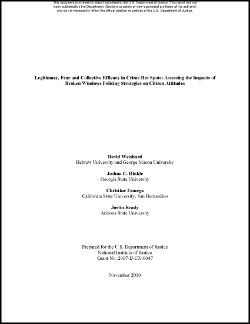
The aim of this study was to examine the impacts of broken windows policing at crime hot spots on fear of crime, ratings of police legitimacy and reports of collective efficacy among residents of targeted hot spots. A block randomized experimental design was employed to deliver a police intervention targeting disorder to 55 treatment street segments with an equal number of segments serving as controls.
The main outcomes were measured using a panel telephone survey of 371 persons living or working in these street segments. Our results showed that the broken windows police intervention delivered to the crime hot spots in this study had no significant impacts on fear of crime, police legitimacy, collective efficacy, or perceptions of crime or social disorder. Perceptions of physical disorder, on the other hand, appear to have been modestly increased in the target areas. The study also did not find statistically significant changes in crime or disorder in official police data, though statistical power for these tests was low as the study was designed around the individual-level tests of the variables discussed above. As a whole, our findings suggest that recent criticisms of hot spots policing approaches which focus on possible negative "backfire" effects for residents of the targeted areas may be overstated.
The study shows that residents are not aware of, or much affected by, a three hour per week dosage of aggressive order maintenance policing on their blocks (in addition to routine police responses in these areas). However, this lack of change also challenges the broken windows thesis as we did not find evidence of the reductions in fear of crime, or the increases in informal social control that would be expected by advocates of broken windows based policing approaches. Future research needs to replicate these findings focusing on varied target populations and types of crime hot spots, while also examining different styles of hot spots policing.
